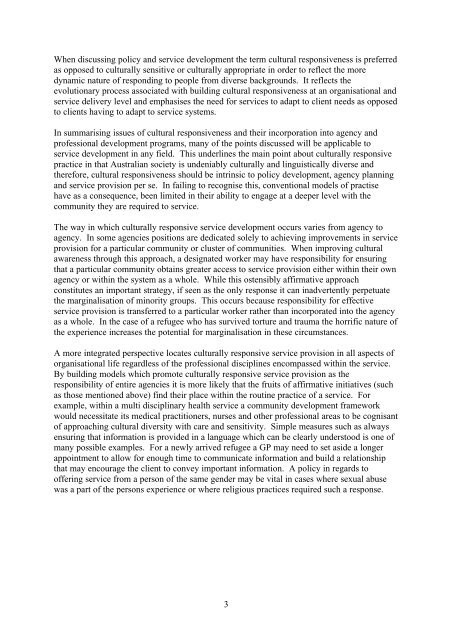Developing cultural responsiveness in the delivery of services to ...
Developing cultural responsiveness in the delivery of services to ...
Developing cultural responsiveness in the delivery of services to ...
You also want an ePaper? Increase the reach of your titles
YUMPU automatically turns print PDFs into web optimized ePapers that Google loves.
When discuss<strong>in</strong>g policy and service development <strong>the</strong> term <strong>cultural</strong> <strong>responsiveness</strong> is preferred<br />
as opposed <strong>to</strong> <strong>cultural</strong>ly sensitive or <strong>cultural</strong>ly appropriate <strong>in</strong> order <strong>to</strong> reflect <strong>the</strong> more<br />
dynamic nature <strong>of</strong> respond<strong>in</strong>g <strong>to</strong> people from diverse backgrounds. It reflects <strong>the</strong><br />
evolutionary process associated with build<strong>in</strong>g <strong>cultural</strong> <strong>responsiveness</strong> at an organisational and<br />
service <strong>delivery</strong> level and emphasises <strong>the</strong> need for <strong>services</strong> <strong>to</strong> adapt <strong>to</strong> client needs as opposed<br />
<strong>to</strong> clients hav<strong>in</strong>g <strong>to</strong> adapt <strong>to</strong> service systems.<br />
In summaris<strong>in</strong>g issues <strong>of</strong> <strong>cultural</strong> <strong>responsiveness</strong> and <strong>the</strong>ir <strong>in</strong>corporation <strong>in</strong><strong>to</strong> agency and<br />
pr<strong>of</strong>essional development programs, many <strong>of</strong> <strong>the</strong> po<strong>in</strong>ts discussed will be applicable <strong>to</strong><br />
service development <strong>in</strong> any field. This underl<strong>in</strong>es <strong>the</strong> ma<strong>in</strong> po<strong>in</strong>t about <strong>cultural</strong>ly responsive<br />
practice <strong>in</strong> that Australian society is undeniably <strong>cultural</strong>ly and l<strong>in</strong>guistically diverse and<br />
<strong>the</strong>refore, <strong>cultural</strong> <strong>responsiveness</strong> should be <strong>in</strong>tr<strong>in</strong>sic <strong>to</strong> policy development, agency plann<strong>in</strong>g<br />
and service provision per se. In fail<strong>in</strong>g <strong>to</strong> recognise this, conventional models <strong>of</strong> practise<br />
have as a consequence, been limited <strong>in</strong> <strong>the</strong>ir ability <strong>to</strong> engage at a deeper level with <strong>the</strong><br />
community <strong>the</strong>y are required <strong>to</strong> service.<br />
The way <strong>in</strong> which <strong>cultural</strong>ly responsive service development occurs varies from agency <strong>to</strong><br />
agency. In some agencies positions are dedicated solely <strong>to</strong> achiev<strong>in</strong>g improvements <strong>in</strong> service<br />
provision for a particular community or cluster <strong>of</strong> communities. When improv<strong>in</strong>g <strong>cultural</strong><br />
awareness through this approach, a designated worker may have responsibility for ensur<strong>in</strong>g<br />
that a particular community obta<strong>in</strong>s greater access <strong>to</strong> service provision ei<strong>the</strong>r with<strong>in</strong> <strong>the</strong>ir own<br />
agency or with<strong>in</strong> <strong>the</strong> system as a whole. While this ostensibly affirmative approach<br />
constitutes an important strategy, if seen as <strong>the</strong> only response it can <strong>in</strong>advertently perpetuate<br />
<strong>the</strong> marg<strong>in</strong>alisation <strong>of</strong> m<strong>in</strong>ority groups. This occurs because responsibility for effective<br />
service provision is transferred <strong>to</strong> a particular worker ra<strong>the</strong>r than <strong>in</strong>corporated <strong>in</strong><strong>to</strong> <strong>the</strong> agency<br />
as a whole. In <strong>the</strong> case <strong>of</strong> a refugee who has survived <strong>to</strong>rture and trauma <strong>the</strong> horrific nature <strong>of</strong><br />
<strong>the</strong> experience <strong>in</strong>creases <strong>the</strong> potential for marg<strong>in</strong>alisation <strong>in</strong> <strong>the</strong>se circumstances.<br />
A more <strong>in</strong>tegrated perspective locates <strong>cultural</strong>ly responsive service provision <strong>in</strong> all aspects <strong>of</strong><br />
organisational life regardless <strong>of</strong> <strong>the</strong> pr<strong>of</strong>essional discipl<strong>in</strong>es encompassed with<strong>in</strong> <strong>the</strong> service.<br />
By build<strong>in</strong>g models which promote <strong>cultural</strong>ly responsive service provision as <strong>the</strong><br />
responsibility <strong>of</strong> entire agencies it is more likely that <strong>the</strong> fruits <strong>of</strong> affirmative <strong>in</strong>itiatives (such<br />
as those mentioned above) f<strong>in</strong>d <strong>the</strong>ir place with<strong>in</strong> <strong>the</strong> rout<strong>in</strong>e practice <strong>of</strong> a service. For<br />
example, with<strong>in</strong> a multi discipl<strong>in</strong>ary health service a community development framework<br />
would necessitate its medical practitioners, nurses and o<strong>the</strong>r pr<strong>of</strong>essional areas <strong>to</strong> be cognisant<br />
<strong>of</strong> approach<strong>in</strong>g <strong>cultural</strong> diversity with care and sensitivity. Simple measures such as always<br />
ensur<strong>in</strong>g that <strong>in</strong>formation is provided <strong>in</strong> a language which can be clearly unders<strong>to</strong>od is one <strong>of</strong><br />
many possible examples. For a newly arrived refugee a GP may need <strong>to</strong> set aside a longer<br />
appo<strong>in</strong>tment <strong>to</strong> allow for enough time <strong>to</strong> communicate <strong>in</strong>formation and build a relationship<br />
that may encourage <strong>the</strong> client <strong>to</strong> convey important <strong>in</strong>formation. A policy <strong>in</strong> regards <strong>to</strong><br />
<strong>of</strong>fer<strong>in</strong>g service from a person <strong>of</strong> <strong>the</strong> same gender may be vital <strong>in</strong> cases where sexual abuse<br />
was a part <strong>of</strong> <strong>the</strong> persons experience or where religious practices required such a response.<br />
3















